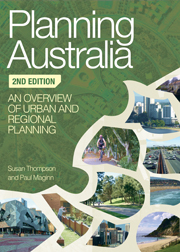Book contents
- Frontmatter
- Contents
- Contributors
- Figures and tables
- Discussion points and case studies
- Preface
- Acknowledgments
- Abbreviations
- Table of statutes
- Introduction
- Part I Frameworks
- Part II Key Issues
- 6 Planning and the natural environment
- 7 The metropolis
- 8 Planning for rural landscapes
- 9 Planning for regions
- 10 Planning for diverse communities
- 11 Aboriginal and Torres Strait Islander Australians
- 12 Community participation in planning
- 13 Urban design
- 14 Planning for heritage conservation and management
- 15 Transport planning
- 16 Healthy planning
- Conclusion: planning Australia into the future
- Index
- References
14 - Planning for heritage conservation and management
from Part II - Key Issues
- Frontmatter
- Contents
- Contributors
- Figures and tables
- Discussion points and case studies
- Preface
- Acknowledgments
- Abbreviations
- Table of statutes
- Introduction
- Part I Frameworks
- Part II Key Issues
- 6 Planning and the natural environment
- 7 The metropolis
- 8 Planning for rural landscapes
- 9 Planning for regions
- 10 Planning for diverse communities
- 11 Aboriginal and Torres Strait Islander Australians
- 12 Community participation in planning
- 13 Urban design
- 14 Planning for heritage conservation and management
- 15 Transport planning
- 16 Healthy planning
- Conclusion: planning Australia into the future
- Index
- References
Summary
Key terms: heritage; heritage conservation; heritage conservation planning; heritage significance; heritage value; cultural significance; fabric; cultural landscape; cultural layering.
Heritage conservation planning in Australia has been closely linked to land-use and environmental planning since the last quarter of the 20th century. Originating from community demands for major planning reforms to protect historic and environmental values in new development, conservation planning today recognises that the landscape carries traces of its earlier uses and meanings– that is, its heritage. Sometimes these meanings are apparent, but often they are intangible or unclear. The heritage conservation planner has the important task of identifying this heritage significance and devising strategies for conserving it.
The practice of heritage conservation planning is both exciting and challenging. As the chapter explains, this is partly because of the debates that attend the very definition of heritage in Australia and elsewhere. Contemporary debates about definitions, of course, reflect the changing relationships between people and their past and present cultural landscapes: these relationships are themselves seen in the history of heritage conservation and planning. The changing importance attached to heritage is also reflected in the statutory and non-statutory systems that regulate heritage conservation and planning, which the chapter describes. The statutory system includes the identification and management of heritage items through legally enforceable structures, and the non-statutory system includes frameworks provided by organisations such as the Australian chapter of the International Council on Monuments and Sites (Australia ICOMOS) and the National Trust. The chapter concludes with a brief exploration of some of the challenges facing the practising conservation planner, including managing multiple understandings of heritage significance, conserving the layered cultural landscape, and protecting heritage significance in the context of other planning objectives such as urban design, consolidation and expansion.
- Type
- Chapter
- Information
- Planning AustraliaAn Overview of Urban and Regional Planning, pp. 331 - 356Publisher: Cambridge University PressPrint publication year: 2012
References
- 1
- Cited by



